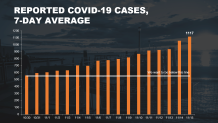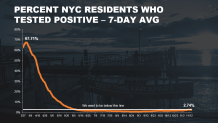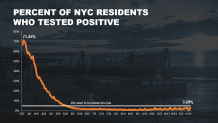What to Know
- New Jersey's new indoor gathering cap (10) goes into effect Tuesday; the outdoor limit will be reduced 70%, from 500 to 150, next week as the state battles its worst COVID increases in months
- New York has also seen significant upticks, prompting Gov. Andrew Cuomo to impose new business restrictions; he also convened an emergency governors summit to discuss new regional measures
- Meanwhile, New York City schools are still teetering on the brink of a switch to all-remote; Mayor de Blasio says if the rolling positivity rate hits 3%, schools go virtual the next day. That number is 2.74% now
Hundreds of thousands of New York City public school parents await what appears to be an almost certain fate in the shutdown of in-person learning, days after Mayor Bill de Blasio told them to have an alternative plan at the ready.
That warning from the mayor came Friday, as the city's seven-day rolling positivity rate came the closest to his 3 percent shutdown threshold that it has ever been. The weekend came and went. Schools stayed open Monday. Schools are open Tuesday. They will be open again Wednesday; the citywide rate is 2.74 percent.
Will kids get another day after that? It's been an every 24-hour question. And anxious parents are still on edge.
For days, it has seemed all but certain New York City's rolling positivity rate would top 3 percent at any point, given the consistent increases in cases. On Tuesday, de Blasio reported the city's seven-day daily case average had hit 1,117, the highest total since May 10. It has risen every day but one since Oct. 29.

The daily positivity rate was 3.2 percent on Tuesday, de Blasio said. Logic says the rolling positivity rate would catch up at some point, one would think. The city is monitoring the data to better understand the correlation.
"Every day matters. Every single day matters. Every day we hold the line keeps people safe and saves lives -- and helps us hold onto that day that's coming soon where there's going to be a vaccine," de Blasio said Tuesday. "Let's do all that we can do to hang tough. Wear that mask. Take those precautions."
To that end, the MTA did have somewhat encouraging news that shows most New Yorkers are doing their part. The agency said 95 percent of riders wear masks, but it's the five percent that still concerns them.
In the meantime, he urged all New Yorkers Tuesday once again to get tested as the city strives to beat back rising COVID rates with the "second wave upon us." The mayor has said if schools do have to switch all-remote, he'd work to get them back to in-person as quickly as possible with additional safety measures.


The mayor has faced growing criticism of the 3 percent threshold for school closure over the last week, given the in-school positivity rate is well below 0.2 percent. Asked again Tuesday about that 3 percent as a benchmark for assessing in-school risk, de Blasio admitted none of the thresholds are perfect.
"Everything with the coronavirus has been the best choices available. They are not perfect choices in general. We are still trying to understand this disease," he said. "Each of the markers we've set, everything is based on the best available data and science. No one is saying it's perfect, but we have to set standards. The 3 percent standard was out of an abundance of caution -- and we stated it as such."
That threshold, which applies only to public schools in the city, was set at a time when the teachers' unions were threatening to strike over allegations in-person learning was unsafe back in August; the need to instill trust was paramount. The same threshold likely won't apply for bringing in-person schooling back if it comes to the point of closure. The city and state are working to devise new benchmarks.
De Blasio has said he's open to incorporating different testing strategies, including the micro-cluster model, in that decision. Ultimately, the hope is to return schools to full in-person instruction five days a week at some point before the 2020-21 academic year ends June 25.
Schools have not been the problem as far as the city and state's rising infection rates, Gov. Andrew Cuomo has said, though he has stopped short of intervening in potential closures. They are, in fact, a bright spot. The same, however, cannot be said of college campuses in the tri-state area and across the country.
A New York Times survey of more than 1,700 U.S. colleges and universities found more than 252,000 COVID cases and at least 80 deaths since the pandemic began. A number of colleges in New York had to move all-remote barely after the fall semester began, some of them as early as August, as they faced outbreaks tied to illicit student gatherings off-campus and smaller collegiate parties.
Many universities cracked down on those early. Many implemented new testing requirements. But with holiday breaks looming, the threat of infected family members via travel, or bringing the virus back to campus via the same means, is of paramount concern to authorities at every level.
The State University of New York, which was hit early and hard with a series of outbreaks across its campus network, announced last month that it would require students to test negative for COVID before they can leave campus for Thanksgiving break. Most of its campuses will switch all-remote after the break.
That could be part of a new sweeping regional strategy Cuomo may unveil in the coming days following an emergency weekend summit with the governors of New Jersey, Connecticut, Pennsylvania and Delaware to discuss potential next steps to curb a COVID resurgence that continues to worsen on a daily basis.
New Jersey Gov. Phil Murphy said in his briefing Monday that guidelines for college students returning from break was a key part of the interstate discussion Sunday, given the volume of people traveling across state and international lines. Murphy said the governors agreed on "fairly specific testing requirement and quarantine" guidelines for college students returning to campus after break.
Connecticut Gov. Ned Lamont addressed the topic in a "Morning Joe" interview Tuesday, saying the gubernatorial coalition, which stretches from Pennsylvania up through Massachusetts, would issue a joint directive to college students.
"If you want to come back to your home state from wherever you're going to college -- say in South Dakota or North Dakota -- you must get tested before you leave," Lamont said. "We'd like it if you quarantine before you leave as well. That's going to keep our people safe and keep their families safe when they get home."
Cuomo, who did not brief reporters by phone or camera Monday or Tuesday, is expected to address the matter in the coming days.
New restrictions had been expected to come from the summit, and Murphy doled out the first of those Monday, announcing indoor gatherings in New Jersey would be limited to 10 starting Tuesday, down from the previous capacity cap of 25. Outdoor gathering caps will be reduced by 70 percent, to 150 from 500, next week as the state battles renewed community spread that has contributed 5 percent of its cumulative case total since March in just four days, Murphy said Monday.
Officials in the tri-state area and across the nation are bracing for the potential impact of Thanksgiving, both in terms of travel and household gatherings. Travel has been a source of spread for some time, hence the quarantine list and now testing entry requirements in New York. The household gatherings have emerged as a key COVID driver in just the last month and a half; officials are concerned.
The mantra has been to avoid travel and to avoid Thanksgiving gatherings as a general rule, but acknowledging many won't heed that advice, officials have suggested people wear masks even when with their own families. New Jersey's health commissioner said Monday singing shouldn't be permitted and music should be low to avoid shouting, which could spew saliva -- and spread COVID.
The city of Hoboken said Monday it would go fully virtual for a week after Thanksgiving break to try to avoid any potential holiday-related spread. Morris County's Mount Olive School District will stay remote through mid-January.
The developments come as New Jersey broke its own single-day pandemic case record twice in two days over the weekend. The state's positivity rate has soared well above 9 percent. All but six of the state's 21 counties reported more than 100 new cases overnight, state data showed Tuesday. An equal number of counties reported more than 300. Hospitalizations are at their highest levels since late May. Murphy reported 38 new deaths Tuesday, the highest daily toll since May 21.
Four mayors within New Jersey's hardest-hit Essex County have agreed to impose a 24-hour shutdown if their numbers continue to worsen, one of the officials told News 4 exclusively. If that doesn't work, they'll move to a three-day shutdown. A spokesperson for Murphy's office says the mayors would need permission from the state to do either.
Both New Jersey and New York are testing at record highs these days, which leads to more cases. That's a plus. As officials have said from COVID's onset, the goal is to find the positives, treat them and isolate them. That's how you reduce spread. The Empire State is faring better than most despite its recent upticks.
New York still holds the third- or fourth-lowest positivity rate in the nation on any given day, but that measure has become relative to the success it had in containing the virus over the summer, where it saw more than a full month of daily positivity rates below 1 percent. The Empire State now has a seven-day rolling average of 2.88 percent and reported a 3.18 percent daily positivity rate Tuesday.
It has averaged more than 4,600 new cases over the last five days, more than quadruple the number it was seeing at the end of October. Hospitalizations are climbing, too.The 2,124 total reported Tuesday is the highest since June 9.
"The number of cases across the country and in New York are only continuing to climb. Despite our success in managing the spread, New York is not immune to this national surge of COVID," Cuomo said in a statement. "Our micro-cluster strategy and testing capacity will help us through this new season, but ensuring we don't go back to where we were in the spring is going to depend on our behavior. Our actions today determine our rate of positive cases tomorrow."
Daily Percentage of Positive Tests by New York Region
Gov. Andrew Cuomo breaks the state into 10 regions for testing purposes and tracks positivity rates to identify potential hotspots. Here's the latest tracking data by region and for the five boroughs. For the latest county-level results statewide, click here
Source: ny.gov
That was six weeks ago. Daily deaths have remained low, but still relatively high compared with the low single digit tolls reported over the summer. Cuomo has said a viral increase associated with the national and international climate, colder weather and holiday travel is inevitable. For him, it's about mitigating the increase.
The New York governor imposed new statewide restrictions last week, including a 10 p.m. indoor service curfew for bars, restaurants and gyms and a 10-person cap on indoor gatherings, including those within private homes. He hopes New Yorkers will be up to the self-enforcement challenge. So does de Blasio.
The mayor flat out said Tuesday the city would not be enforcing the 10-person limit on gatherings within private homes. He said he hoped people would use common sense, echoing comments made by NYPD Commissioner Dermot Shea earlier in the day during an interview on NY1.
"We're not planning on breaking up Thanksgiving celebrations, but we need to be smart. We're encouraging everyone to use common sense," Shea said.
If that doesn't happen, stricter rules may come. Indoor dining could be next on the chopping block, Cuomo has warned.
Tracking Coronavirus in Tri-State
The recent tri-state battles are reflective of national struggles amid a COVID surge that has left no state untouched. The United States has not reported fewer than 100,000 new daily COVID cases since doing it for the first time amid the pandemic on Nov. 4. On Friday, it reported nearly 200,000 new cases in one day. Its cumulative case and death tolls far surpass any nation in the globe.
Experts say life in the U.S. won't return to any semblance of normalcy until there is an effective and widely available vaccine. That may not happen for months, despite encouraging news from Pfizer. Moderna followed up with its own positive news Monday, saying it expects to file for emergency approval of its vaccine in the "coming weeks," with 20 million doses ready to ship this year.
Cuomo wasn't quite as bullish on the vaccine timeline, however, saying on MSNBC that the vaccine "production schedule" will have to be ramped up considerably if the goal is to make it available to everyone by spring 2021. He also said it will take a "massive effort" to ensure equitable access, reiterating previous concerns about reaching underserved and minority communities, which have been hit disproportionately by the virus and its fallout from the onset of the pandemic.
Even when a safe, effective vaccine is approved, delivery and distribution to millions of Americans remain a mammoth challenge for governors. And Dr. Anthony Fauci, the nation's leading infectious disease expert, says people should not abandon masks or social distancing even after they've been vaccinated.
"Even though, for the general population, it might be 90[%] to 95% effective," Fauci said, reporting to effectiveness rates shown in Pfizer and Moderna trials, "you don't necessarily know, for you, how effective it is."
Up to 10 percent of immunized people could still get the virus, even at those high success rates, CNBC reported.



